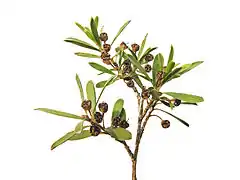Kunzea phylicoides
Kunzea phylicoides, commonly known as the slender burgan,[2] is a flowering plant in the myrtle family, Myrtaceae and is endemic to south-eastern Australia. It is an erect shrub with drooping branches, fibrous or corky bark, bright green, narrow leaves and clusters of white flowers in spring.
| Slender burgan | |
|---|---|
 | |
| Kunzea parvifolia Mount Buffalo National Park, Victoria | |
| Scientific classification | |
| Kingdom: | Plantae |
| Clade: | Tracheophytes |
| Clade: | Angiosperms |
| Clade: | Eudicots |
| Clade: | Rosids |
| Order: | Myrtales |
| Family: | Myrtaceae |
| Genus: | Kunzea |
| Species: | K. phylicoides |
| Binomial name | |
| Kunzea phylicoides | |
| Synonyms[1] | |
| |
Description
Kunzea phylicoides is a graceful, erect shrub which typically grows to a height of 3 m (10 ft) and has drooping branches and fibrous or corky bark. The leaves are linear to narrow lance-shaped, 7–25 mm (0.3–1 in) long and 1–2 mm (0.04–0.08 in) wide on a petiole 0.5–1 mm (0.02–0.04 in) long. The flowers are arranged singly or in groups of up to three in the upper leaf axils, each flower on a pedicel 3–6 mm (0.1–0.2 in) long. There are no bracts or bracteoles at the base of the flower. The sepals are green, reddish near the base, triangular and 1–1.5 mm (0.04–0.06 in) long. The petals are white, more or less round, 1.5–2.5 mm (0.06–0.1 in) long and there usually 25 to 35 white stamens that are 1–4 mm (0.04–0.2 in) long with some shorter than the petals. The style is 1.5–2.5 mm (0.059–0.098 in) long. Flowering mostly occurs from November to February and the fruit is 2.5–4 mm (0.1–0.2 in) long, 3–5 mm (0.1–0.2 in) wide and not woody.[2]
Kunzea phylicoides is similar K. ericoides but has a more graceful habit, leafy groups of flowers and about twice as many stamens. It sometimes hybridises with K. peduncularis.[2]
Taxonomy and naming
Slender burgan was first formally described in 1843 by Johannes Conrad Schauer after an unpublished description by Allan Cunningham who gave it the name Baeckea phylicoides. The description was published in Wilhelm Walpers's Repertorium Botanices Systematicae.[3][4] In 1917, George Claridge Druce changed the name to Kunzea phylicoides.[5] The specific epithet (phylicoides) refers to a similarity of this species to others in the genus Phylica. The ending -oides is a Latin suffix meaning "like", "resembling" or "having the form of".[6]
Distribution
Kunzea phylicoides grows along the Snowy River and its tributaries in New South Wales, the Australian Capital Territory and Victoria.[2]
References
- "Kunzea phylicoides". Australian Plant Census. Retrieved 25 March 2019.
- Messina, Andre; Stajsic, Val. "Kunzea phylicoides". Royal Botanic Garden Victoria. Retrieved 25 March 2019.
- "Baeckea phylicoides". APNI. Retrieved 25 March 2019.
- Schauer, Johannes Conrad (1843). Wilhelm Gerhard Walpers (ed.). Repertorium botanices systematicae. New York: Sumtibus Friderici Hofmeister. p. 921. Retrieved 25 March 2019.
- "Kunzea phylicoides". APNI. Retrieved 25 March 2019.
- Brown, Roland Wilbur (1956). The Composition of Scientific Words. Washington, D.C.: Smithsonian Institution Press. p. 483.